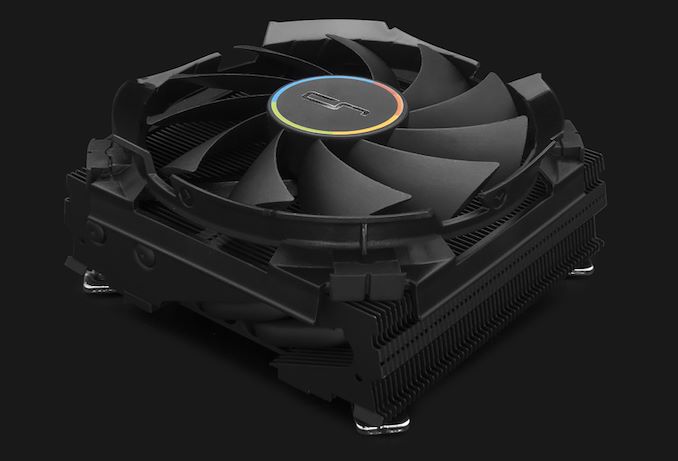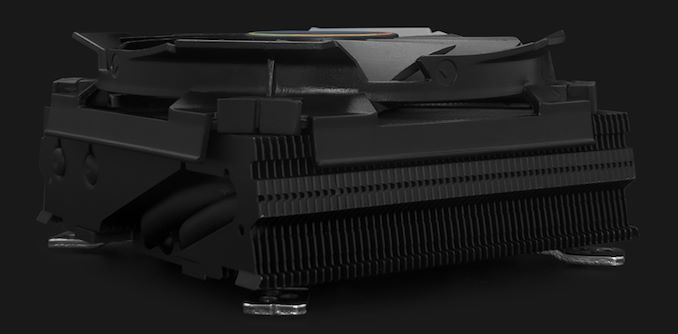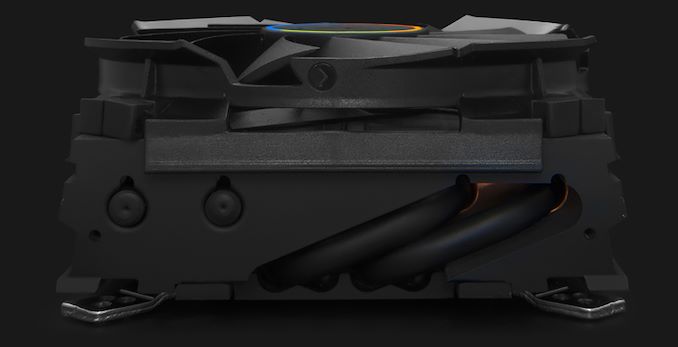Cryorig C7 G Is A 47mm Low-Profile Cooler with a Graphene Coating, Rated for 125W
by Anton Shilov on September 26, 2019 3:00 PM EST- Posted in
- Cooler
- AMD
- Intel
- Cases/Cooling/PSUs
- cryorig

Cryorig has introduced its low-profile CPU cooling system for small form-factor PCs that can dissipate up to 125 W. Featuring a 47-mm z-height and a 97-mm depth/width, the Cryorig C7 G is among the smallest coolers for higher-end processors available today. To make C7 G's high performance possible, Cryorig had to apply graphene coating on the heatsink.
As owners of SFF PCs demand higher-performance components, cooling designers are creating low-profile coolers rated for TDP levels of 95 W of higher. To maximize efficiency of such devices, manufacturers use copper for heatsinks, many heat pipes, and large fans. Cryorig decided to go one step further and applied graphene coating to the radiator’s fins. Thermal conductivity of graphene is in the range of 3000 - 5000 W/mK at room temperature (according to Graphene-Info), which is considerably higher than thermal conductivity of aluminum (250 W/mK at 25ºC) or copper (401 W/mK at 25ºC), so applying it on the fins could theoretically improve cooling performance.
Just like regular Cryorig’s C7, the model C7 G features four 6-mm heat pipes and a 97-mm PWM fan with 11 curved blades that rotates at a speed of 600 – 2500 RPM producing airflow of up to 40.5 CFM as well as rated for a maximum load noise level of 30 dB(A).
As far as compatibility is concerned, the Cryorig C7 G cooling system can work with all modern platforms from AMD and Intel, including the latest AM4 and LGA1155 sockets.
| The Cryorig C7 G Specifications | ||||
| C7-G | ||||
| CPU TDP | 125 W | |||
| Material | Copper base, graphene covered fins | |||
| Dimension with Fan | 97 mm (W) × 47 mm (H) × 97 mm (D) | |||
| Heat Pipes | 4 × 6 mm heat pipes | |||
| Air Pressure | ~ 1.36 mm H2O | |||
| Air Flow (CFM) | 40.5 CFM | |||
| Speed | 600 ~ 2500 RPM | |||
| Noise | up to 30.2 dBA | |||
| Type of Bearing | ? | |||
| Life Expectancy | ? | |||
| Weight | 673.5 grams | |||
| Compatibility | AMD | AM4/FM2+/FM2/FM1/AM3+/AM3/AM2+/AM2 | ||
| Intel | LGA1151/1150/1155/1156 | |||
Cryorig’s C7 G cooler will be available in Japan starting September 28 for ¥9,960 without sales tax ($92.50), which is certainly higher than average for an air cooler. Evidently, graphene coating is expensive and dissipating up to 125 W using a cooling system featuring a 47 mm z-height is a unique capability, so the price can be justified. The unit is already listed on the company’s website, so its launch in other countries is imminent.
Related Reading:
- ID Cooling IS-50X Low-Profile SFF Cooler, Rated for 130 W TDP
- ID Cooling Unveils IS-30 Low-Profile 30-mm Cooler for 100 Watt CPUs
- SilverStone Launches 33mm Nitrogon NT08-115XP CPU Cooler for Ultra-Thin PCs
- 3-Way Low Profile CPU Cooling Shoot-Out: Reeven, Phanteks, & Noctua
Source: Cryorig (via Hermitage Akihabara)












57 Comments
View All Comments
Kevin G - Thursday, September 26, 2019 - link
Ummm.... why would you want just the surface fo the heat sink to be graphene? It is indeed a great thermal conductor but the surface of a material is responsible for actually radiating out the heat with air. Wouldn't it be wiser to select a material that is better suited for that application? Graphene would be great for the core material of a heat sink though.ShieTar - Friday, September 27, 2019 - link
Because grapheme by definition is a surface material. Carbon molecules in a bulk would be graphite or coal, neither one having a particularly high thermal conductivity. Or diamond, which would work very well, but even with polycrystalline artificial diamonds, that would produce the most expensive cooling component of all times, somewhere beyond 10000$ for even a small form factor cooler.But yeah, graphene coating the copper definitely won't reduce the blocks overall thermal conductivity, it will only increase it by a very, very small fraction. Or at least it can't reduce the conductivity from CPU to Air overall, in theory it might help a bit to equalize the temperature profile on the fin surface in case the air cools it unevenly.
mikato - Friday, September 27, 2019 - link
If that is the case, it seems nonsensical to compare the thermal conductivity to copper or aluminum.Santoval - Friday, September 27, 2019 - link
Because graphene is a "2-D" ("2-D" is employed as a figure of speech to mean "extremely thin", not in a mathematically rigorous sense, because that can only exist in pure math) material. It can only be applied as a coating of one to a few, maybe up to a few tens, graphene layers. The 3-D version of graphene is graphite and that will certainly not do because graphite's properties are markedly different.My black body radiation physics knowledge is currently a bit of rusty at the moment; is a surface with a higher thermal conductivity better or worse at thermal radiation? My guess is that it's better : a near perfect black body with a high thermal conductivity surely absorbs heat better than a black body with a low thermal conductivity.
Better heat absorbers are also better heat radiators. Hence, assuming the graphene layer was applied correctly, it should increase the heat radiation from the radiator's fins (and, conversely, in a hot environment that is warmer than the radiator, the graphene should increase the heat absorption).
bcronce - Sunday, September 29, 2019 - link
Actually, graphene follows the electric resistance of a mathematical 2d universe.peevee - Tuesday, October 1, 2019 - link
"My black body radiation physics knowledge is currently a bit of rusty at the moment; is a surface with a higher thermal conductivity better or worse at thermal radiation?"Radiation has almost nothing to do with how air coolers work.
shabby - Thursday, September 26, 2019 - link
Can't wait for graphene coated rgb's!Jon Tseng - Friday, September 27, 2019 - link
Would the black colour have an impact on better heat radiation? I seem to remember something about colour impacting thermal properties from school physics classes although I have not idea about the quanta (best guess would be only a degree or two anyone else have a better idea?)ShieTar - Friday, September 27, 2019 - link
Sure, but since the fins can only radiate towards the fin next to it, which is also black and absorbs all the radiated heat again, that gives you no net effect => 0°C.A radiating cooler needs to be oriented towards something very cold, like deep space when you use it on satellites. There the difference is massive, a polished metal surfaces has a emissivity of less than 10%, while a black coated surface can have an emissivity of very close to 100% => Radiating more than 10x the power.
Jorgp2 - Friday, September 27, 2019 - link
Isn't the idea to release the heat from the radiator?As in transfer it into the air.
A surface painted black will do a better job than a shiny metal surface.